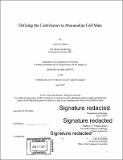| dc.contributor.advisor | Matthew G. Vander Heiden. | en_US |
| dc.contributor.author | Hosios, Aaron M. (Aaron Marc) | en_US |
| dc.contributor.other | Massachusetts Institute of Technology. Department of Biology. | en_US |
| dc.date.accessioned | 2017-09-15T15:30:52Z | |
| dc.date.available | 2017-09-15T15:30:52Z | |
| dc.date.copyright | 2017 | en_US |
| dc.date.issued | 2017 | en_US |
| dc.identifier.uri | http://hdl.handle.net/1721.1/111363 | |
| dc.description | Thesis: Ph. D., Massachusetts Institute of Technology, Department of Biology, 2017. | en_US |
| dc.description | Cataloged from PDF version of thesis. Vita. | en_US |
| dc.description | Includes bibliographical references. | en_US |
| dc.description.abstract | Proliferation can be thought of as the sum of many biosynthetic processes. To proliferate, a cell must not only physically divide but must also newly synthesize each of its components as it progresses through the cell cycle. Metabolism allows a cell to meet these demands. Metabolic alterations associated with proliferating cells have been characterized, and increasing research interest seeks to provide mechanistic and teleological insight into these metabolic alterations. The following dissertation provides a framework for understanding how proliferating mammalian cells use the nutrients available to them to synthesize macromolecule precursors that are ultimately used to synthesize new cell mass. Substantial research efforts have focussed on the abilities of glucose and glutamine to serve as sources of biosynthetic material for cell growth, especially since proliferating cells avidly consume these nutrients. Many other nutrients are consumed at much lower rates, and we have quantified how each contributes to biosynthesis, demonstrating that amino acids are the primary contributors to mammalian cell mass. Although glucose consumption does not directly relate to its contribution to cell mass, glycolytic flux is important to sustain cell growth, and activation of this pathway is thought to promote biosynthesis. To better understand regulation of this pathway, we have explored the biochemical properties of two glycolytic enzymes, pyruvate kinase and enolase. Although pyruvate kinase isoform M2 (PKM2) expression enables proliferation in some contexts, we demonstrate that this is not because of its putative activity as a protein kinase. We additionally characterize a novel modification of enolase by its substrate, phosphoenolpyruvate, which can covalently modify a catalytic residue and inhibit enzyme activity. These studies collectively contribute to an understanding of how metabolism can support rapid proliferation in mammalian cells, and lay the foundation for future studies to understand proliferative metabolism. | en_US |
| dc.description.statementofresponsibility | by Aaron M. Hosios. | en_US |
| dc.format.extent | 213 pages | en_US |
| dc.language.iso | eng | en_US |
| dc.publisher | Massachusetts Institute of Technology | en_US |
| dc.rights | MIT theses are protected by copyright. They may be viewed, downloaded, or printed from this source but further reproduction or distribution in any format is prohibited without written permission. | en_US |
| dc.rights.uri | http://dspace.mit.edu/handle/1721.1/7582 | en_US |
| dc.subject | Biology. | en_US |
| dc.title | Defining the contributors to mammalian cell mass | en_US |
| dc.type | Thesis | en_US |
| dc.description.degree | Ph. D. | en_US |
| dc.contributor.department | Massachusetts Institute of Technology. Department of Biology | |
| dc.identifier.oclc | 1003291167 | en_US |

